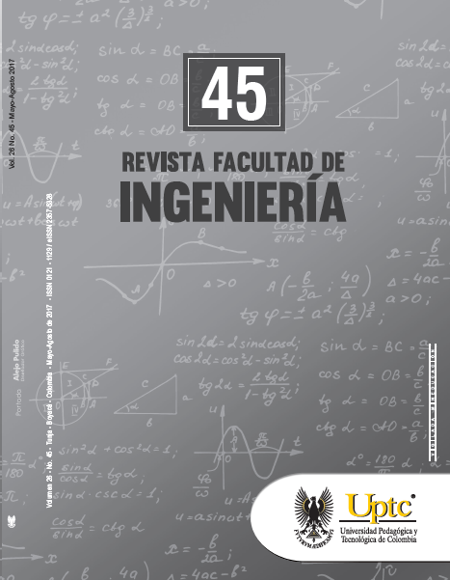Visualización de áreas urbanas inundables del piedemonte amazónico con Multiagentes Vectores Naturales Geoinspirados (AVNG)

Resumen
En la literatura especializada se encuentran diferentes formas de calcular y visualizar áreas inundadas por entidades geográficas (ríos o quebradas), usando modelos matemáticos y físicos en 1D y 2D; también se usan herramientas como los Sistemas de Información Geográfica (SIG), la lógica difusa, las redes neuronales, y los algoritmos genéticos, entre otros. En el presente artículo se muestra el uso de Agentes Vectores Naturales Geoinspirados (AVNG).
El AVNG parte del concepto de agente, integrando el modelo vectorial GIS para lograr la construcción de un elemento capaz de representar de forma dinámica una entidad geográfica (Vector) a partir de dos comportamientos: el natural y el inducido (Agente Natural), logrando generar una aproximación a la gestión ambiental.
Con el propósito de implementar el modelo conceptual del AVNG, se presenta un estudio de caso en la región del piedemonte amazónico colombiano, donde las inundaciones repentinas en las áreas urbanas causan desastres materiales y pérdidas de vidas humanas.
Palabras clave
Áreas inundadas, Computación ambiental, Computación bioinspirada, Gestión ambiental
Citas
- Secretaría General de la Comunidad Andina, "Agenda ambiental Andina 2012-2016, Bolivia, Colombia, Euador y Peru," Pull Creativo SRL, Lima-Peru, 2012.
- M. Batty, "GeoComputation using cellular automata," in Geocomputation, pp. 95-126, 2000.
- A. W. Jayawardena, E. D. Perera, B. Zhu, J. D. Amarasekara, and V. Vereivalu, "A comparative study of fuzzy logic systems approach for river discharge prediction," Journal of hydrology, vol. 514 (1), pp. 85-101, 2014. DOI: http://doi.org/10.1016/j.jhydrol.2014.03.064. DOI: https://doi.org/10.1016/j.jhydrol.2014.03.064
- S. Vitabile, V. Conti, C. Militello, and F. Sorbello, "An extended JADE-S based framework for developing secure Multi-Agent Systems," Computer Standards & Interfaces, vol. 31 (5), pp. 913-930, Sep. 2009. DOI: http://doi.org/10.1016/j.csi.2008.03.017. DOI: https://doi.org/10.1016/j.csi.2008.03.017
- S. H. Chen, A. J. Jakeman, and J. P. Norton, "Artificial Intelligence techniques: An introduction to their use for modelling environmental systems," Mathematics and Computers in Simulation, vol. 78 (2-3), pp. 379–400, Jul 2008. DOI: http://doi.org/10.1016/j.matcom.2008.01.028. DOI: https://doi.org/10.1016/j.matcom.2008.01.028
- E. E. Millán Rojas, and J. N. Perez Castillo, " Una aproximación de la gestión ambiental para la predicción de áreas inundables en el piedemonte amazónico, usando agentes naturales por medio de la computación bioinspirada," in Twelfth LACCEI Latin American and Caribbean Conference for Engineering and Technology, pp. 1-9, 2014.
- M. S. Horritt, and P. D. Bates, "Evaluation of 1D and 2D numerical models for predicting river flood inundation," Journal of Hydrology, vol. 268 (1-4), pp. 87-99, Nov. 2002. DOI: http://doi.org/10.1016/S0022-1694(02)00121-X. DOI: https://doi.org/10.1016/S0022-1694(02)00121-X
- Y. Hammam, A. Moore, and P. Whigham, "The dynamic geometry of geographical vector agents," Computers, Environment and Urban Systems, vol. 31 (5), pp. 502-519, Sep. 2007. DOI: http://doi.org/10.1016/j.compenvurbsys.2007.08.003. DOI: https://doi.org/10.1016/j.compenvurbsys.2007.08.003
- D. Weyns, H. V. D. Parunak, F. Michel, T. Holvoet, and J. Ferber, "Environments for multiagent systems state-of-the-art and research challenges," Environments for multi-agent systems, vol. 3374, pp. 1-47, 2005. DOI: https://doi.org/10.1007/978-3-540-32259-7_1
- H. Parunak, R. Bisson, and S. A. Brueckner, "Agent interaction, multiple perspectives, and swarming simulation," in Proceedings of the 9th International Conference on Autonomous Agents and Multiagent Systems, 2010.
- O. El-Kholy, The world environment 1972–1992: Two decades of challenge, Netherlands: Springer, 2012.
- G. A. Espinoza, Gestión y fundamentos de evaluación de impacto ambiental, Santiago de Chile: BID/CED, 2006.
- L. V. Mora, Gestión ambiental sistémica, Sigma, 2001.
- M. J. Wooldridge, An introduction to multiagent systems, Liverpool: Summer, 2009, pp. 1-39.
- J. Ferber, Multi-agent systems: an introduction to distributed artificial intelligence, Manchester: Addison-Wesley, 1999.
- R. A. Johnson, Advanced euclidean geometry, Courier Corporation, 2013.
- JADE, "jadeworld". Available: http://www.jadeworld.com/developer-center/download-jade/.
- Geotools.org, "Geotools.org". Available: http://geotools.org/.
- A. V. Sandita, and C. I. Popirlan, "Developing A Multi-Agent System in JADE for Information Management in Educational Competence Domains," Procedia Economics and Finance, vol. 23, pp. 478-486, 2015. DOI: http://doi.org/10.1016/S2212-5671(15)00404-9. DOI: https://doi.org/10.1016/S2212-5671(15)00404-9
- Open Geospatial Consortium, "OGC". Available: http://www.opengeospatial.org/.
- I. Turton, "Geo tools," Open source approaches in spatial data handling, vol. 2, pp. 153-169, 2008. DOI: http://doi.org/10.1007/978-3-540-74831-1_8. DOI: https://doi.org/10.1007/978-3-540-74831-1_8
- IDEAM, «Datos IDEAM,» Available: http://www.ideam.gov.co.
- L. Sauvé, "Educación ambiental y ecociudadania. Dimensiones claves de un proyecto político-pedagógico," Revista Científica, vol. 1 (18), pp. 12-23, 2014. DOI: https://doi.org/10.14483/23448350.5558
- D. J. Marceau, and I. Benenson, Advanced Geo-Simulation Models, Bentham Science Publishers, 2011. DOI: https://doi.org/10.2174/97816080522261110101